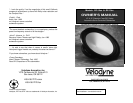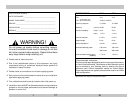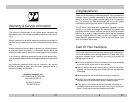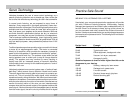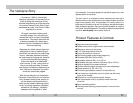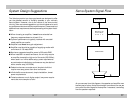
Servo Technology
Velodyne pioneered the use of servo-control technology as a
means of reducing distortion over a decade ago. Now, we are the
first to offer this revolutionary technology for use in the automobile.
In normal music listening, we are exposed to many forms of
distortion. Every component in the signal path adds it's own char-
acteristic distortion to the signal. Since most high quality electronics
available now have distortion levels far lower than we are able to
hear, that leaves your speakers as the worst offenders. While we
scrutinize distortion specifications before we buy an electronic
component, we rarely see anyone list distortion on loudspeakers.
That is because traditional subwoofers (even high quality types)
can produce distortion levels around 25% at typical levels. Even at
only one watt input power, many subwoofers produce from 8-10%
distortion.
Traditional speakers produce sound by using a cone which is forced
to move by an electromagnetic motor. The motor is connected
directly to an amplifier, which provides the necessary increase in
power to drive the speaker. If a speaker was functionally "perfect",
this method would work fine. The problem arises when the fast
moving speaker cone is called upon to stop & change direction
quickly. The speaker cone may continue to move, resulting in
muddy bass with an increased amount of harmonic distortion.
Unfortunately there is no way for this traditional system to "control"
distortion. Until now.
Velodyne's patented servo-control system uses a "motional feed-
back loop", which corrects for any distortion. Here's how it works.
The music signal that normally goes to your amp is re-routed to our
control unit. This unit monitors the music signal, which should be
reproduced exactly without distortion. We then mount two acceler-
ometers on the speaker. One accelerometer monitors cone motion,
while the other accounts for motion of the vehicle. Now that we can
monitor the actual motion of the cone, we can instantaneously
compare how well the acoustic output of the speaker matches the
music signal. If & when the output from the speaker starts to deviate
from the music signal, the servo circuitry modifies the drive signal
3
☞
8
☞
Practice Safe Sound
WE WANT YOU LISTENING FOR A LIFETIME!
Used wisely your new sound reproduction equipment will provide
you with a lifetime of listening pleasure. Unfortunately, hearing
damage from exposure to loud noise is often undetectable until it is
too late. Since it is all too easy to keep "turning up the volume" so
you can overcome road noise, we would like to issue this word of
caution. Velodyne recommends that you avoid prolonged exposure
to excessive sound pressure levels. The following list is included for
your protection.
Decibel Level Example
40 dB Quiet library, soft whispers
50 dB Typical quiet room
60 dB Office equipment, background noise
70 dB Vacuum, hair dryer, restaurant
80 dB Average city traffic
Sustained exposure to levels of noise higher than this can be
dangerous to your hearing.
90 dB Subway, motorcycle, lawn mower
100 dB Garbage truck, power tools
120 dB Live rock concert
140 dB Gunshot (close range), jet plane
180 dB Rocket launching pad
Information courtesy of Deafness Research Foundation.



